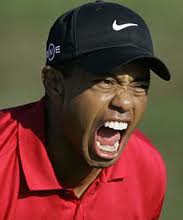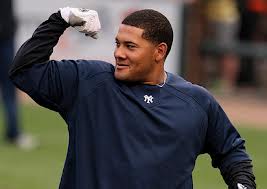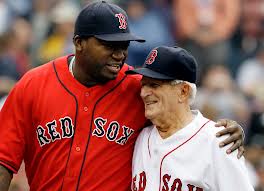Byrce Harper is a baseball prodigy. His awe-inspiring talent defies someone who is just
19-years old. Harper was labeled as "The Chosen One" by Sports Illustrated when he was
just 16-years and made it to the Major Leagues three years later. In his rookie season,
Harper became an All-Star for the Washington Nationals.
The game has allowed the teenager to showcase his talent, but it has also exposed
his immaturity and temper. He has broken bats over his knee, slammed them, as well as
helmets, to the ground, and argued with umpires over bad calls. Harper can launch
baseball's 450 feet, but baseball has caused him to erupt like a volcano, at times.
The game can do that to a player. They experience failure far more often than they do
success. The best hitters in the game fail 70 percent of the time, if a player does that over
a 15-year career, he's a Hall of Fame. If a quarterback does that, he's far worse than
Tim Tebow. If a shooter does that in basketball, he'd be out of the game quicker than
Antoine Walker blew through his $100 million fortune.
During the course of a baseball season, which lasts from February to October, failure is
everywhere. Combine that with the stress of the game and playing for your livelihood,
tantrums like the one's Harper has exhibited, and dugout demolitions we've seen highlighted
by ESPN when guys like Carlos Zambrano erupt. It's baseball. It happens.
In August of 1988, one of the greatest dugout demolitions in the history of the game
happened. I was a member of the Lynchburg Red Sox and we were in pennant race
against their fierce division rivals, the Salem Buccaneers. The affects of a long and
stressful season were wearing on all of us. In the minor-leagues, you travel on rickety
buses, make little money, and get handed a per diem of just $12-a-day, which wouldn't
be enough for three extra value meals at McDonald's. It's anything but glamorous.
On this steamy Virginia night, all the stress and failure resulted in the perfect storm for
a dugout demolition of epic proportions. Jim Orsag was our power-hitting first basemen,
who also happened to be in a race with Bernie Willaims for the Carolina League batting title.
Williams, who would go on to a spectacular career with the New York Yankees, was just
19-years old at the time, and his style and demeanor was far, far different than that of
Orsag.
A third-year pro out of the University of Illinos, Orsag was half-Seabiscuit, half-
Schwarzeneggar. He was 6'3" and a magnificently sculpted 225 lbs. He ran like a
Thoroughbred coming down the stretch at the Kentucky Derby with nostrils flaring
and scary, intimidating sounds emitting from his lungs. The ground shook beneath him
and there wasn't a second baseman in baseball who wanted to have to turn a double-play
with Orsag bearing down on him. He played the game with the intensity of Ray Lewis
and seemed far better suited for playing football on Sunday's than trying to make it
to Major Leagues. With his spiked hair and physical resemblance to Arnold Schwarzeneggar,
Orsag was our "Terminator."
Orsag was hitting .328 when he stepped in to face Scott Ruskin in his first at-bat of the night.
Ruskin was a left-hander who wasn't overpowering, but was very smart and could locate
the ball well, while baffling hitters with his hard-biting curve ball. Ruskin went on to play
five years in the big leagues with the Pirates, Reds, and Expos.
On this night, Ruskin had Orsag's number, striking him out in their first three confrontations.
Slowly making his way back to the dugout, you could see the steam starting to come out of
the ears of Orsag. He was a prideful man who took his job and career seriously. With the
game in just the 6th inning, Orsag already had the "Hat Trick", a three-strikeout performance.
The only thing worse than that, is the "Golden Sombrero", a four-strikeout game which
no hitter wants any part of. Orsag picked that up the very next inning and that's when you
could see the volcano inside of him begin to simmer. It didn't help that a fan, an elderly
woman, who was probably never missed a game in that venerable, old stadium, shouted to
Orsag, "Hey, it's going to be a cold winter and I need some kindling wood. You don't
seem to be using your bat, can I have it?"
Players avoided Orsag the way they do when a pitcher has a no-hitter going. We stayed as
far away from Orsag as we possibly could. This was just a bad night, which every player
experiences from the minor to the major leagues. He had that look in his eye that said,
"Don't talk to me and don't come near me." Nobody did. Orsag was in a hitter's hell and
the best thing to do was stay away from him and be ready for when the volcano
erupts.
Mount St. Orsag erupted in the top of 9th inning. Ruskin had been replaced by Rick Reed,
another pitcher who carved out a nice career in the big leagues with the Pirates and New
York Mets. He was a pitcher that threw up "tossed salad", an array of off-speed pitches
that drove power-hitters like Orsag nuts. He struck out Orsag to lead off the inning. Five
at-bats, five strikeouts. A golden sombrero plus one.
When Orsag arrived after the long walk back from home plate, it was as if time stood
still. The stadium got quiet, real quiet. I was halfway between the bat rack and the end
of the bench wearing my catcher's gear. I slowly put on my catcher's mask for my own
protection. I knew what was coming next.
Using the bat he had just struck out for the fifth time, Orsag whacked the bat rack shattering
his Louisville Slugger in two. But he wasn't done. Far from it. He shattered another, then
another. He was picking bats randomly out of the rack and turning them into kindling wood
for that little old lady in the stands. Jim Bibby, who was our pitching coach and one of the
largest human beings I've ever seen, just watched in amazement.
Bibby was a 12-year major league veteran who had witnessed a lot of meltdowns in his
career, but nothing like this. "Holy Mother F*@#king S*^%!" was all Bibby could say
as he stared at Orsag's performance. This was legendary. After Orsag had destroyed the
fifth and final bat, he just sauntered back to his spot on the bench as if nothing happened.
Players on the other team watched it all in utter amazement. The umpires looked on
incredulously. Fans choked on their popcorn.
There was a silent pause that seemed to last for a minute. Nobody moved and it was eerily
quiet. And then, as if starting the game all over again, the home plate umpire said, "Play ball!"
and the game went on again, as if nothing happened, except that one of the greatest dugout
demolitions did, and everyone who was there that night, has never forgotten it.
Orsag finished the season with a .324 average with an spectacular on-base percentage of
.434. Williams won the batting crown with a .335 mark. Orsag was the best teammate I've
ever had and a lot of players on the Lynchburg Red Sox will tell you the same thing. He
played the game hard on every single play on every single night. His demolition was the
stuff of legend and no way diminished his season or what he represented. Orsag was intense,
driven, incredibly hardworking, and quite simply, a great man and teammate.
19-years old. Harper was labeled as "The Chosen One" by Sports Illustrated when he was
just 16-years and made it to the Major Leagues three years later. In his rookie season,
Harper became an All-Star for the Washington Nationals.
The game has allowed the teenager to showcase his talent, but it has also exposed
his immaturity and temper. He has broken bats over his knee, slammed them, as well as
helmets, to the ground, and argued with umpires over bad calls. Harper can launch
baseball's 450 feet, but baseball has caused him to erupt like a volcano, at times.
success. The best hitters in the game fail 70 percent of the time, if a player does that over
a 15-year career, he's a Hall of Fame. If a quarterback does that, he's far worse than
Tim Tebow. If a shooter does that in basketball, he'd be out of the game quicker than
Antoine Walker blew through his $100 million fortune.
During the course of a baseball season, which lasts from February to October, failure is
everywhere. Combine that with the stress of the game and playing for your livelihood,
tantrums like the one's Harper has exhibited, and dugout demolitions we've seen highlighted
by ESPN when guys like Carlos Zambrano erupt. It's baseball. It happens.
In August of 1988, one of the greatest dugout demolitions in the history of the game
happened. I was a member of the Lynchburg Red Sox and we were in pennant race
against their fierce division rivals, the Salem Buccaneers. The affects of a long and
stressful season were wearing on all of us. In the minor-leagues, you travel on rickety
buses, make little money, and get handed a per diem of just $12-a-day, which wouldn't
be enough for three extra value meals at McDonald's. It's anything but glamorous.
On this steamy Virginia night, all the stress and failure resulted in the perfect storm for
a dugout demolition of epic proportions. Jim Orsag was our power-hitting first basemen,
who also happened to be in a race with Bernie Willaims for the Carolina League batting title.
Williams, who would go on to a spectacular career with the New York Yankees, was just
19-years old at the time, and his style and demeanor was far, far different than that of
Orsag.
A third-year pro out of the University of Illinos, Orsag was half-Seabiscuit, half-
Schwarzeneggar. He was 6'3" and a magnificently sculpted 225 lbs. He ran like a
Thoroughbred coming down the stretch at the Kentucky Derby with nostrils flaring
and scary, intimidating sounds emitting from his lungs. The ground shook beneath him
and there wasn't a second baseman in baseball who wanted to have to turn a double-play
with Orsag bearing down on him. He played the game with the intensity of Ray Lewis
and seemed far better suited for playing football on Sunday's than trying to make it
to Major Leagues. With his spiked hair and physical resemblance to Arnold Schwarzeneggar,
Orsag was our "Terminator."
Orsag was hitting .328 when he stepped in to face Scott Ruskin in his first at-bat of the night.
Ruskin was a left-hander who wasn't overpowering, but was very smart and could locate
the ball well, while baffling hitters with his hard-biting curve ball. Ruskin went on to play
five years in the big leagues with the Pirates, Reds, and Expos.
On this night, Ruskin had Orsag's number, striking him out in their first three confrontations.
Slowly making his way back to the dugout, you could see the steam starting to come out of
the ears of Orsag. He was a prideful man who took his job and career seriously. With the
game in just the 6th inning, Orsag already had the "Hat Trick", a three-strikeout performance.
The only thing worse than that, is the "Golden Sombrero", a four-strikeout game which
no hitter wants any part of. Orsag picked that up the very next inning and that's when you
could see the volcano inside of him begin to simmer. It didn't help that a fan, an elderly
woman, who was probably never missed a game in that venerable, old stadium, shouted to
Orsag, "Hey, it's going to be a cold winter and I need some kindling wood. You don't
seem to be using your bat, can I have it?"
Players avoided Orsag the way they do when a pitcher has a no-hitter going. We stayed as
far away from Orsag as we possibly could. This was just a bad night, which every player
experiences from the minor to the major leagues. He had that look in his eye that said,
"Don't talk to me and don't come near me." Nobody did. Orsag was in a hitter's hell and
the best thing to do was stay away from him and be ready for when the volcano
erupts.
Mount St. Orsag erupted in the top of 9th inning. Ruskin had been replaced by Rick Reed,
another pitcher who carved out a nice career in the big leagues with the Pirates and New
York Mets. He was a pitcher that threw up "tossed salad", an array of off-speed pitches
that drove power-hitters like Orsag nuts. He struck out Orsag to lead off the inning. Five
at-bats, five strikeouts. A golden sombrero plus one.
When Orsag arrived after the long walk back from home plate, it was as if time stood
still. The stadium got quiet, real quiet. I was halfway between the bat rack and the end
of the bench wearing my catcher's gear. I slowly put on my catcher's mask for my own
protection. I knew what was coming next.
Using the bat he had just struck out for the fifth time, Orsag whacked the bat rack shattering
his Louisville Slugger in two. But he wasn't done. Far from it. He shattered another, then
another. He was picking bats randomly out of the rack and turning them into kindling wood
for that little old lady in the stands. Jim Bibby, who was our pitching coach and one of the
largest human beings I've ever seen, just watched in amazement.
Bibby was a 12-year major league veteran who had witnessed a lot of meltdowns in his
career, but nothing like this. "Holy Mother F*@#king S*^%!" was all Bibby could say
as he stared at Orsag's performance. This was legendary. After Orsag had destroyed the
fifth and final bat, he just sauntered back to his spot on the bench as if nothing happened.
Players on the other team watched it all in utter amazement. The umpires looked on
incredulously. Fans choked on their popcorn.
There was a silent pause that seemed to last for a minute. Nobody moved and it was eerily
quiet. And then, as if starting the game all over again, the home plate umpire said, "Play ball!"
and the game went on again, as if nothing happened, except that one of the greatest dugout
demolitions did, and everyone who was there that night, has never forgotten it.
Orsag finished the season with a .324 average with an spectacular on-base percentage of
.434. Williams won the batting crown with a .335 mark. Orsag was the best teammate I've
ever had and a lot of players on the Lynchburg Red Sox will tell you the same thing. He
played the game hard on every single play on every single night. His demolition was the
stuff of legend and no way diminished his season or what he represented. Orsag was intense,
driven, incredibly hardworking, and quite simply, a great man and teammate.





































































.jpg)